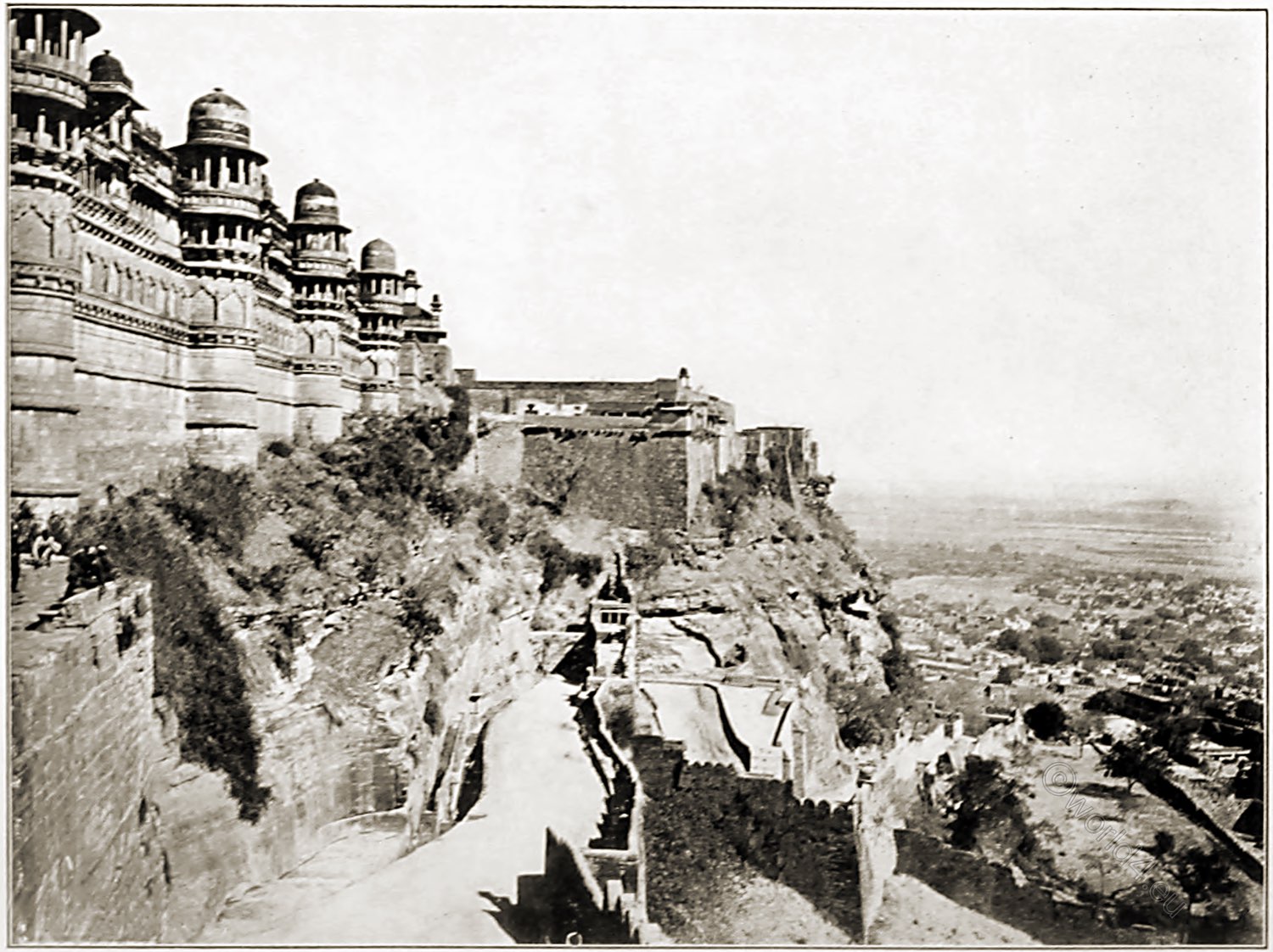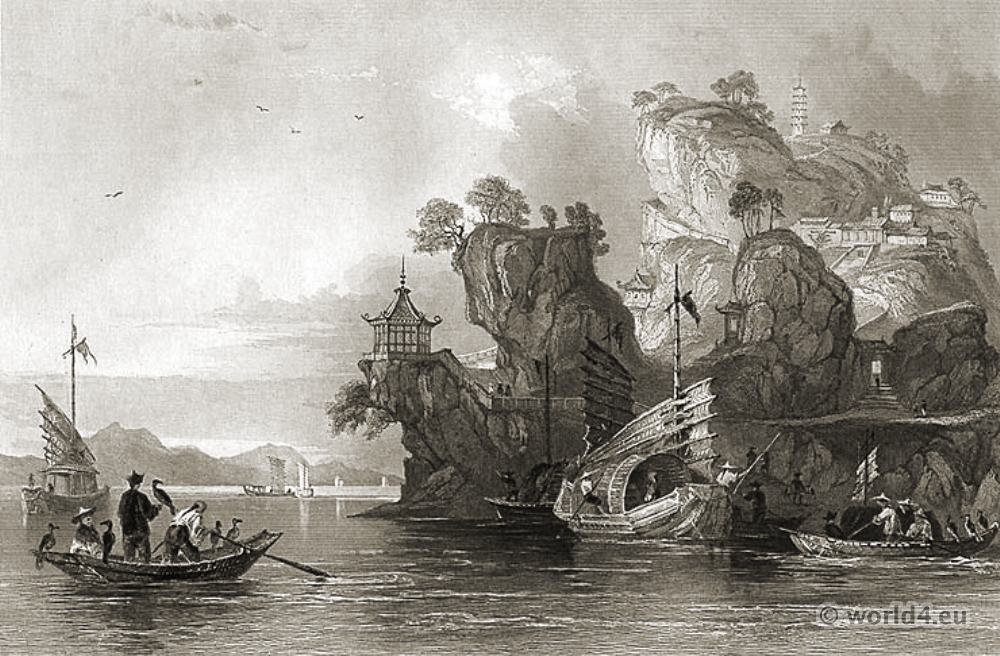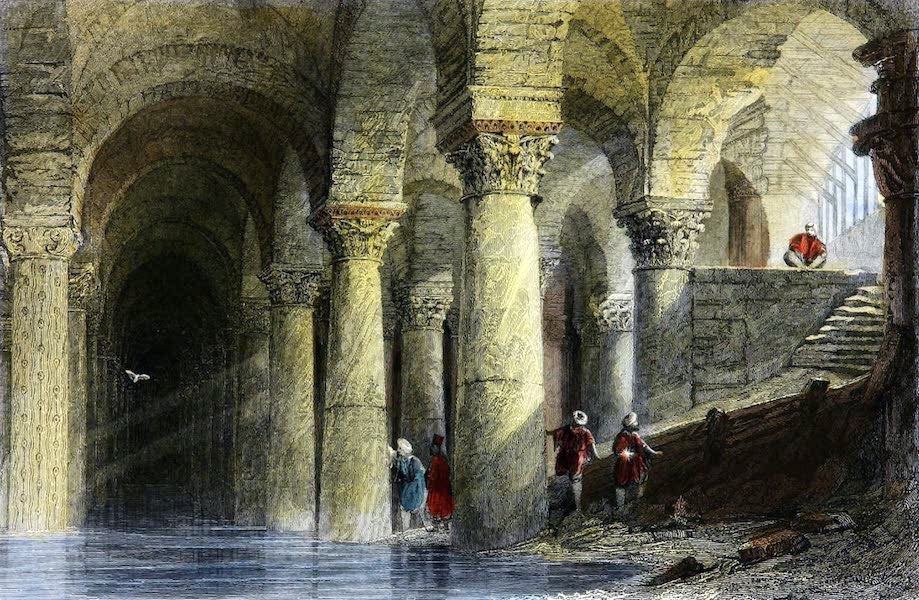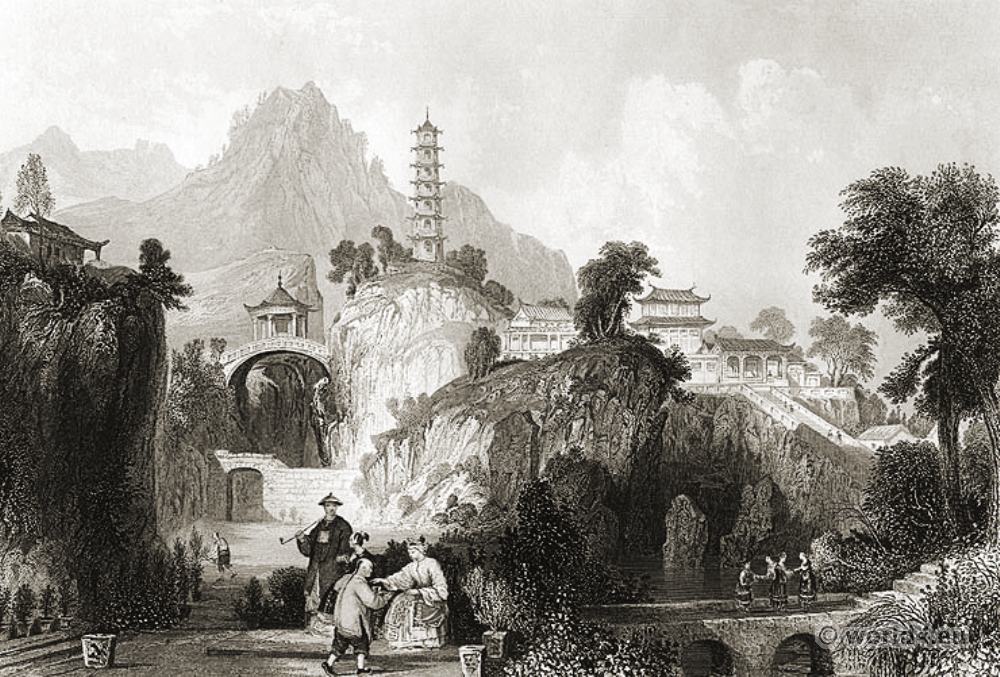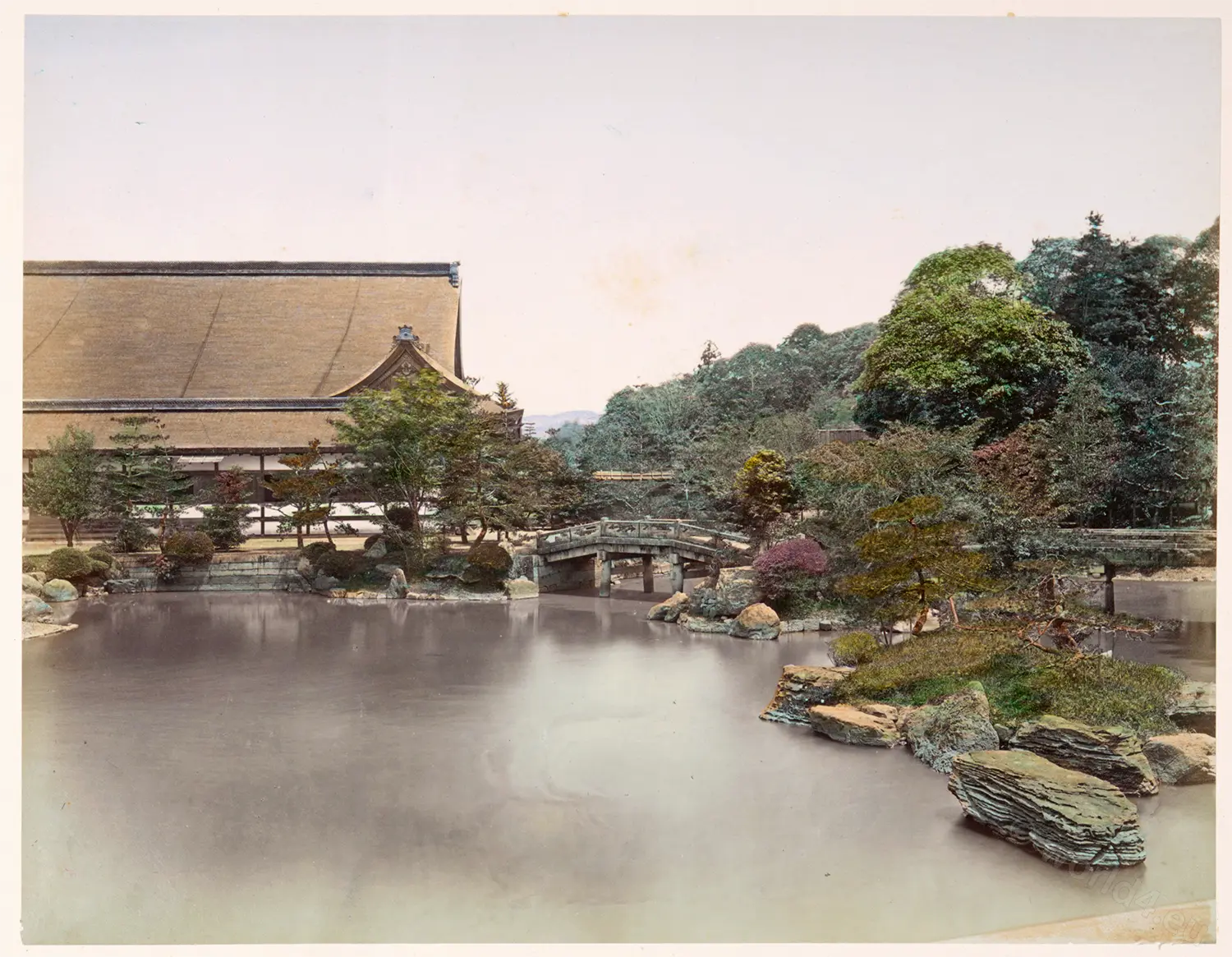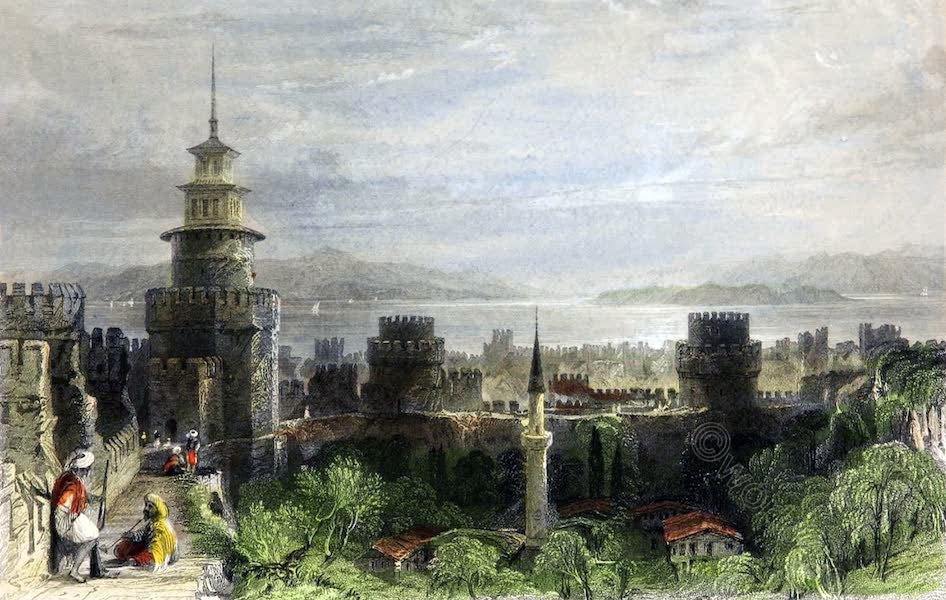THE FORTRESS AND PALACE OF GWALIOR
By LOUIS ROUSSELET *)
THE ancient city of Gwalior, which must not be confounded with the modern town of that name, nor with the Mahratta camp of the Scindias, is situated on the summit of a steep and isolated rock, 342 feet in height at the north end, where it is highest, and a mile and a half in length; its greatest breadth is 300 yards. Its position and the exterior appearance of its fortifications, behind which rise numerous monuments, remind one of Chittore, the famous capital of Meywar.
This rock, which is a block of basalt topped with sandstone, stands like a sentinel at the entrance of a valley and above the slopes at its foot rise pointed cliffs, forming natural ramparts, on which are built the fortifications of the town.
Tradition places the date of the founding of Gwalior several centuries before the Christian era. The attention of the Aryan colonists from the valley of the Chumbul probably was early attracted by the admirable position of this rock. The first to establish themselves here were no doubt the Anchorites, who were sent forth in such numbers by the Indian schools of philosophy in the Sixteenth and Seventeenth Centuries before the Christian era, as is attested by the numerous caverns, formed by man, in the sides of the rock.
In 773, Rajah Sourya Sena completed a system of defence round the plateau by constructing ramparts. The Kâchwas held the fortress until the reign of Tej Pal Doula, who, upon being expelled by the Chohans in 967, founded the dynasty of Ambir.
Sultan Shahab Oudin’s generalissimo, Koutub Eibeck, took it from the Chohans in 1196; and thirty-eight years later it was again taken by the Emperor Altamsh after a long siege. In 1410, the Touar Rajpoots got possession of it, and held it until 1519, when it was finally attached to the crown of Delhi by Ibrahim Lodi.
At the dismemberment of the Mogul Empire, it fell alternately into the hands of the Jâts and Mahrattas. In 1779, it was garrisoned by Scindia, from whom it was taken by a British force under Major Popham, and it was again made over to Scindia by the treaty of 1805.
But the vicissitudes of the ancient fortress did not end here. In 1857, Maharajah Scindia having refused to countenance the revolt, the rebels, under the command of one of Nana Sahib’s captains, took the place but General Sir Hugh Rose dislodged them by planting his batteries on the surrounding heights, and, for the purpose of protecting the young king from his rebellious subjects, the English kept possession of the plateau.
The present town of Gwalior extends to the north and east of the fortress, being hemmed in between the rock and the river Sawunrika. It was a large and handsome settlement, containing thirty or forty thousand inhabitants; but the founding of a new capital by the Scindias, at a distance of about two miles was a death-blow to its grandeur, the higher branches of trade and the nobility having followed the Court to Lashkar.
The architecture of its stone houses is, for the most part, handsome but the streets are narrow and crooked. It is probable that at one time there was a large suburb round the foot of the ascent leading to the fortress, but it was not until the Sixteenth Century that the town assumed its present proportions. There are no monuments to be found of an earlier date; and the two worthy of remark are the Jummah Musjid, a handsome mosque, flanked by two lofty minarets, and the Hatti Durwaza, or “Gate of the Elephants,” a curious triumphal arch, situated on a mound at the entrance to the town.
The bazaars of Gwalior contain several manufactures peculiar to the place, such as silken fabrics, embroidered in gold, for turbans; sarris, or cotton scarfs for women, and curious stuffs in the most brilliant colours. A very fair trade is carried on in these articles.
Two flights of steps, one on the east and the other on the west, lead up to the fortress; of which that on the east is a notable achievement, since it had to be cut out of the solid rock. It is the more ancient of the two and, although on a very steep incline, it is practicable for horses and elephants.



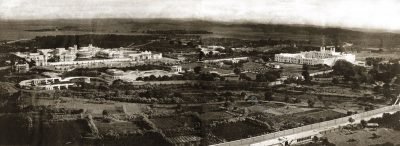
In order to reach this elevation, you must traverse the whole length of the lower town; and the entrance to it is guarded by an embattled fortification and guard houses. Hidden among the trees, at a short distance, stands a large palace, the exterior of which is ornamented with bright blue enamel. Five monumental gates, placed at intervals, and still armed with portcullis and heavy iron doors, guard the access to the fortress. From the first, which is a splendid triumphal arch with a Saracenic archway, and surmounted by a tier of small columns, commences the causeway, which, although wide and well kept, is a long and fatiguing ascent; and thence also commences a series of monuments, bas-reliefs, caverns, and cisterns, forming a natural museum of great interest to the archaeologist. Even the rocks which overhang the road merit his attention, for they contain numerous chambers, altars and statues, which are reached by narrow paths, requiring a steadv head and a sure and practised foot.
Between the third and fourth gate are some huge tanks, excavated out of the solid rock, and fed by springs. The capitals of the pillars which support the ceiling appear above the water, and one can scarcely distinguish the bottom in the obscurity. Near these tanks the surface of the rock, which has been made smooth and even, is covered with numerous bas-reliefs; one of the largest of which, representing an elephant and rider, still is easily distinguishable in spite of considerable mutilation; and further on is a head of Siva.
Opposite the fourth gate is a small monolith of great antiquity, supposed to date from the Fifteenth Century. It is a temple cut out of a single block of stone, and consists of a small square room, entered by a peristyle and crowned with a pyramidal spire. The upper portion of the latter, having been destroyed, has been replaced by a small dome in Stonework; and a few sculptures surround the entrance to the sanctuary and the altar.
On the summit of the hill stands King Pal, which sprinss from the very brink of the precipice. It is supported by six towers, and pierced by only a few large windows ornamented with balconies and pilasters. Sculptured bands, Jain arches, and indented cordons relieve the monotony of the massive exterior, and give it a peculiarly light and graceful appearance. The spaces between the Jain arches of the gallery are filled in and covered with mosaics in enamelled bricks, representing palm-trees on a blue ground and each tower is surmounted by a lantern with a double row of columns. It is difficult to imagine a grander or more harmonious effect than that produced by this gigantic edifice, combining rampan and palace in one.
At the south angle of the palace is a gateway, which gives access to the interior of the fortress, and through which you enter a narrow street that overlooks the lateral frontage of the palace. This is built on the same plan as the exterior, but here the stone is completely hidden by enamel. Bands of mosaics, representing candelabra, Brahma ducks, elephants and peacocks in blue, rose-colour, green and gold, give this immense blank wall an incomparably beautiful appearance. The bricks of which these mosaics are composed still retain their primitive brilliancy of colour and delicacy of shading, though ten centuries have passed over them. I know of no country in the world where an architect has succeeded so well in giving a graceful appearance to a heavy blank wall.
The exact date of the construction of these facings is unknown, though it is certain that they were the work of a Rajpoot prince of the name of Pal; but, as several Chandela and Kachwa chiefs bore this name, it is difficult to fix the date more precisely than between the Eighth and Ninth Centuries.
The palace of the kings of Gwalior covers an immense area on the east of the plateau; but it was not the work of a single prince; the most ancient portions of it date back to the Sixteenth Century. Each dynasty enlarged the mass of buildings, and the Moguls themselves made considerable additions to it. The interior of the Palace of Pal is extremely simple in style. The various stories, which you enter through rows of square pillars, overlook the large paved courts and the rooms are low with flat ceilings.
Among these ruins a portion of the ancient palace of the Vaishnava kings may still be seen. The thick walls, pierced with triangular openings, are somewhat in the same style as the corridors of the Mexican temples. It is to be regretted that so much of this part of the Palace has already been destroyed.
The northern extremity of the plateau, which gradually becomes narrower and narrower, was entirely covered by the palaces of the Emperors Akbar and Jehanghir; but you do not find here the magnificent buildings of Agra or of Delhi. It is evident that these were mere provincial residences. There are nevertheless, a graceful dewani-khas and a small zenanah, containing some fine galleries.
Source: Historic buildings as seen and described by famous writers by Esther Singleton (1865-1930). New York: Dodd, Mead & company, 1903.
*) Louis-Théophile Marie Rousselet (1845-1929) was a French traveller, writer, photographer and pioneer of the darkroom.
Continuing

